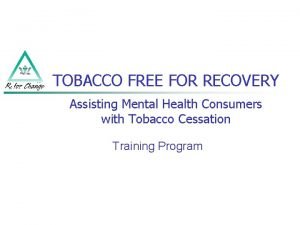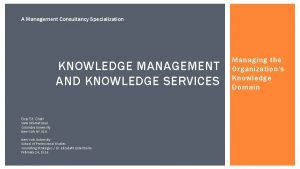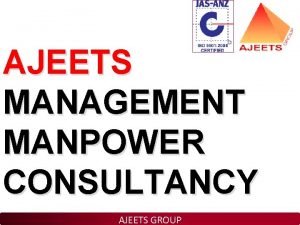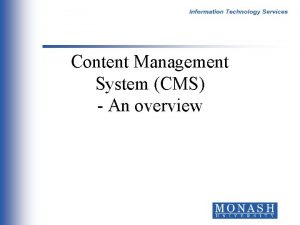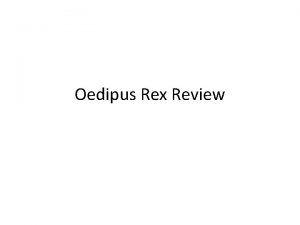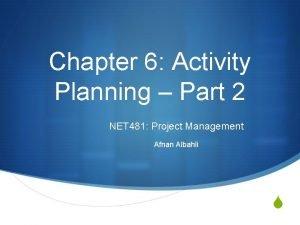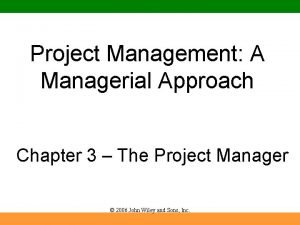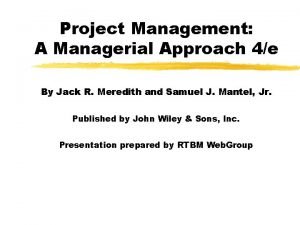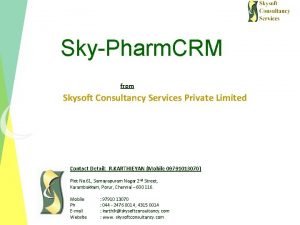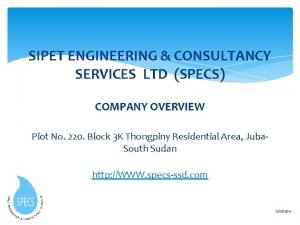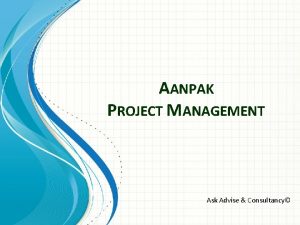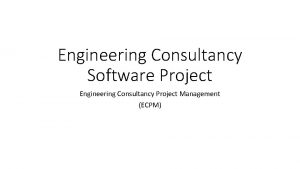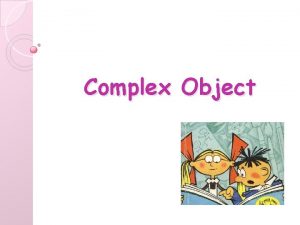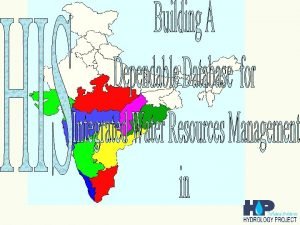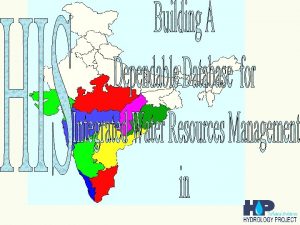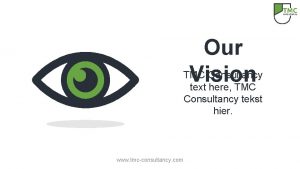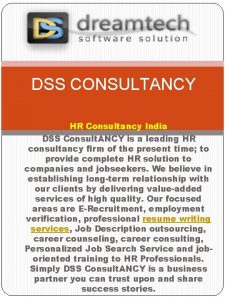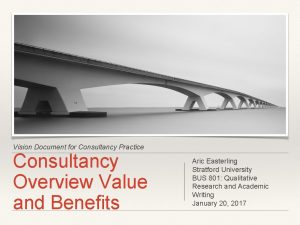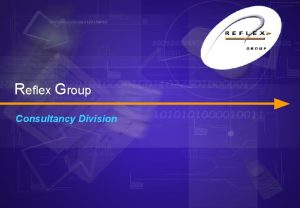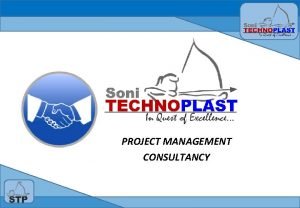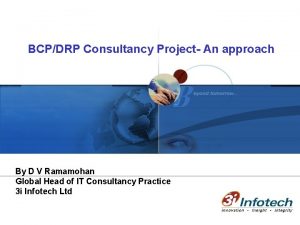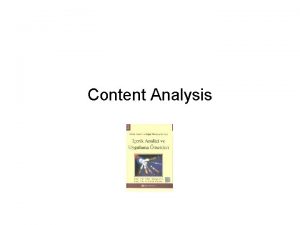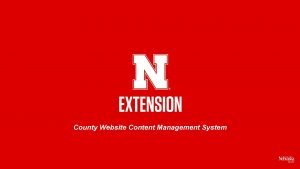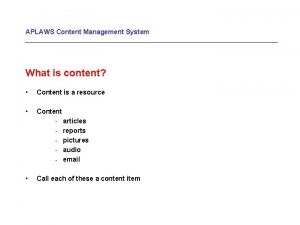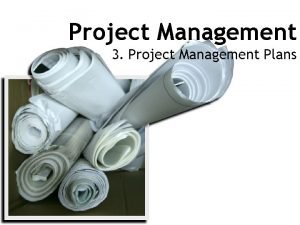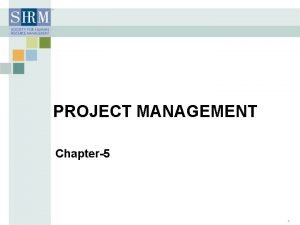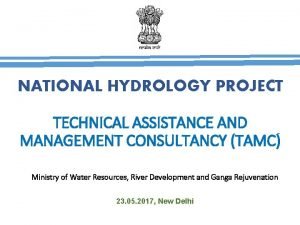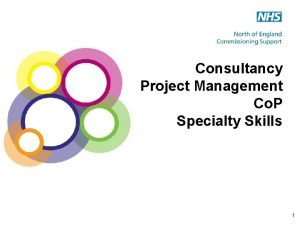APPROACH PROJECT MANAGEMENT Ask Advise Consultancy Welcome Content
























- Slides: 24

APPROACH PROJECT MANAGEMENT Ask Advise & Consultancy©

Welcome

Content Presentation • • • What is a Project? Characteristics of a Project What is Project Management? Projecten management with Prince 2 method Why the PRINCE 2 method? Conclusion.

What is Project? A project is a temporary organizaton that is created for the purpose of delivering one or more business products according to an Business Case.

Characteristics of a Project • Change • Temporary • Cross-functional • Unique • Uncertainty - - Projects are the means by which we introduce change. Projects are temporary by nature. Projects should have a defined start and defined end. Once the desired change has been implemented, business as usual resumes. Projects involve a team of people with different skills working together (temporary) to introduce a change. Every project is unique in some way: a different team, different customer, different location. Projects are more risky than business as usual, they have more threats and opportunities.

What is Project Management? Project Management is: - Planning, delegating, monitoring and control all aspects of the project - Motivation of those involved to achieve the project objectives - Within the expected performance targets: time, cost, quality, scope, benefits and risks.

PRINCE 2 (PRojects IN a Controlled Environment)

Why the PRINCE 2 method? The PRINCE 2 method addresses project management with four integrated elements: 1. 2. 3. 4. Principles Themes Processes Project environment. Prince 2 is generic, it can be applied to any project regardless of project scale, type, organization, geography or culture.

7 Principles 1. 2. 3. 4. 5. 6. 7. Continued business justification Learn from experience Defined roles and responsibilities Manage by stage Manage by exception Focus on products Tailor to suit the project environment.

Explanation Principes Principles explanation 1. 1. Continued business Voortdurende zakelijke justification rechtvaardiging • • • Justifiable reason to start a project. Justification should remain valid. Justification is documented and approved. 2. Learn from experience • Lessons are sought, recorded and acted upon throughout the life of a project. At the project start, during the deployment of the project and at project closure. • 3. Defined roles and responsibilities • • 4. Manage by stages Defined an agreed roles and responsibilities within an organization structure that engages the business, user and supplier stakeholder interests. Project Management structure > answer the question: What is expected of me? Project is planned, monitored and controlled on a stage-bystage basis. • At the end of each stage, project should be assessed to review BC and plans to ensure that the project remains viable, and a decision made as to whether to proceed. *A project contains at least two stages: an initiation stage and one or more management stages. •

Explanation Principles explanation 5. Manage by exception • • • 6. Focus on Products • • • 7. Tailored to suit the project environment • • Appropriate governance by defining distinct responsibilities for directing, managing and delivering the project. Accountability at each level defined. Delegating authority from one level to the next by setting tolerances against six objectives for the respective level of the plan: time, cost, quality, scope, risk, benefits. Focus on the definition and delivery of products, in particular their quality requirments. A successful project is output-oriented not activity oriented. The set of agreed products defines the scope of a project and provides the basis for planning and control. PRINCE 2 is tailored to suit the project’s environment, size, complexity, importance, capability and risk. The purpose is that the method relates to the environment, e. g. alligning with business processes that may govern and support the project, such as human resources, finance and procurement and also for reporting and reviewing frequency and formality.

7 Themes 1. 2. 3. 4. 5. 6. 7. Business Case Organization Quality Plans Risk Change Progress.

Explanation Themes Theme explanation 1. Business Case • • 2. Organization • • • 3. Quality • • Mechanisms to judge whether the project is (and remains) desirable, viable and achievable. Used to make decisions about the investment and continuation to support. Define and establish the project’s structure of accountability and responsibilities. Have business, user and supplier stakeholder representation. Ensure appropriate governance by defining responsibilities for directing, managing and delivering the project and defining accountability at each level. Reviews project roles throughout the project to ensure that they continue to be effective. Effective strategy to manage communication flows to and from stakeholders. Define and implement the means by which the project will create products that are fit for purpose. Meet business expectations, achieve benefits and satisfy stated needs. A product can also be a person, process, a service and/or a system. Focus of quality is on a product’s ability to meet its requirements or specifications.

Explanation Themes Theme explanation 4. Plans • • 5. Risk • • • To facilitate communication and control by defining the means of delivering products (where and how, by whom, and estimating the when and how much) is a baseline against progress can be measured. What is required, how it will be achieved and by whom, using what specialist equipment and resources. When events will happen. Whether targets (time, cost, quality, scope, risk and benefits) are achievable. Identify, assess and controle uncertainty and, as a result, improve the ability of the project to succeed. A risk is an uncertain event or set of events that, should it occur, wil have an impact on the achievement of objectives. It consists of a combination of the probability of a perceived threat or opportunity occuring and the magnitude of its impact on objectives.

Explanation Themes Theme explanation 6. Change • Identify, access and control any potential and approved changes to the baseline. 7. Progress • Mechanisms to monitor and compare actual achievements against those planned. Prognoses project goals and justify continuing viability of the project. Controle unacceptable differences. Controle progress: result compare with plan, plan and options review future situation. Indentify risk and problems. Take corrective actions. Approve next stage / tasks. Tolerances against obejectives for the respective level of the plan, without the escalation to next management level. • • *All 7 themes must be applied in a project but they should be tailored according the scale, nature and complexity of the project concerned.

7 Processes 1. 2. 3. 4. 5. 6. 7. • • • Starting Up a Project Directing a Project Initiating a Project Controlling a Stage Managing Product Delivery Managing a Stage Boundary Closing a Project. A proces is a structured set of activities designed to accomplish a specific objective. Processes are required to direct, manage and deliver a project successfully. Prior to the activity to fully scope the project, it is important to verify that the project is worthwhile and viable.

Explanation Processen 1. Staring Up a Project • • Do we have a vialbe and worthwhile project? The trigger for a project is the Project Mandate > design Project Brief and Stage plan for the project initiation. 2. Directing a Project • • The trigger is the request to initiate the project. Enable the Project Board to be accountable for the project’s success by making key decisions and exercising overall control while delegating day-to-day management of the project to the Project Manager. Objectives: authority to initiate the project; authority to deliver the project’s products; management directions and control are provided throughout the project’s life; and that the project remains vialbe. Corporate program management has an interface with project. Authority to close the project. Plan for realizing the post-project benefits are managed en reviewed. • •

Process explanation 3. Initiating a Project • • • 3. Controlling a stage • • Trigger is approval to initiate the project. Ensure a common understanding of: reason doing the project, expected benefits and associated risks. The scope of what is to be done and the products to be delivered. How and when the project’s products will be delivered and at what cost. Who is to be involved in the project decision making. How the quality required will be achieved. How baselines will be established and controlled. How risks, issues and changes will be identified, assessed and controlled. How progress will be monitored and controlled. Who needs information, in what format, and at what time. How method will be tailord to suit the project. De trigger is approval for the next phase or a Exception Plan. Purpose is to assign work to be done, monitor such work, deal with issues, report progress to the Project Board, and take corrective actions to ensure that the stage remains within the tolerance.

Process explanation 4. In addition Controlling a Stage • • • 5. Managing Product Delivery • • • Attention is focused on delivery of the stage’s products. Any movement away from the direction and products agreed at the start of the stage is monitored to avoid uncontrolled changes (‘scope creep’) and loss of focus. Risks and issues are kept under controle. Business Case is kept under review. Agreed products for the stage are delivered to stated quality standards, within cost, effort and time agreed, and ultimately in support of the achievement of the defined benefits. Project team is focused on delivery within the tolerances laid down. The trigger is approval to realise the Work Package. The aim is to controle the link between Project Manager and the Team Manager(s), by placing formal requirements on accepting, executing and delivering project work. The objective within this process is: work on products allocated to the team is authorized and agreed. Team Managers, team members and suppliers are clear as to what is to be produced and what is the expected effort, cost and timescales. Planned products are delivered to expectations and within tolerance. Project Manager will receive accurate progress information at an agreed frequency to ensure that expectations are managed.

Process explanation 6. Managing a Stage Boundary • • • 7. Closing a Project • • • De trigger is the request to approve an Exception Plan or to approve the next Stage Plan. Purpose is that Project Board will be provided with sufficient information by the PM so that it can review the success of the current stage, approve the next Stage Plan, review the updated Project Plan, and confirm continued business justification and acceptabiltiy of the risks. Objective is to assure the Project Board that all products in this Stage Plan have been completed and approved; Prepare Stage Plan for the next stage; Project Initiation Document (PID) review and update it if needed. Assess the continuing viability and risks. Record information and lessons learned. Request authorization to start the next stage. A project has a start and an end. The purpose of this process is to provide a fixed point at which acceptance for project’s products is confirmed and to recognize that objectives set out in the original PID have been achieved. Objectives: verify user acceptance of the project’s products; ensure that the host site is able to support the products when the project is disbanded. Review the performance on the project against its baseline. Assess any benefits that have already been realized, update the forecast of the remaining benefits, and plan for a review of those unrealized benefits. Ensure that provisioning has been made to address all open issues and risks, with follow-on action recommendations.

Project environment Tailoring refers to the appropriate use of PRINCE 2 on a given project, ensuring that there is the correct amount of planning, control, governance and use of the processes and themes, whereas the adoption of PRNCE 2 across an organization is known as embedding. Tailoring does not consist of omitting elements of PRINCE 2. It is a web of interlinking elements: themes are used in processes; techniques are undertaken to bring themes to life; and individuals fulfilling project roles create management product. The goal is to apply a level of project management that does not overburden the project but provides an appropreate level of controle given the external and project factors.

Conclusions • In a dynamic world with the current speed of technology changes where business and social Legal & Regulatory increase, disadvantages of project failures becomes more clear. The Balance between Business As Usual and Organization Changes became extremely important. PRINCE 2 is a structured method supporting to manage changes and projects successfull, if properly applied.

QUESTIONS? INFO@ASK-ADVISE. NL

Information / Source • Managing Successful Projects with Prince 2 2009 • www. prince 2. com
 Ask advise refer
Ask advise refer Ask assess advise
Ask assess advise What's your favourite foot
What's your favourite foot Ask tell ask feedback model
Ask tell ask feedback model Consultant knowledge management
Consultant knowledge management Wellness tourism consultancy
Wellness tourism consultancy Ajeets group
Ajeets group Importance of software project management
Importance of software project management Cms project management
Cms project management What is esp
What is esp Static content vs dynamic content
Static content vs dynamic content Writing to argue
Writing to argue What made oedipus go to the oracle when he was young?
What made oedipus go to the oracle when he was young? Mind verb pattern
Mind verb pattern Doctor advise
Doctor advise Askwonder
Askwonder Shipping advice is sent by
Shipping advice is sent by Activity based approach in software project management
Activity based approach in software project management Project management a managerial approach
Project management a managerial approach Activity planning in software project management
Activity planning in software project management Project management a managerial approach
Project management a managerial approach Skysoft consultancy services
Skysoft consultancy services Sipet engineering and consultancy services
Sipet engineering and consultancy services Sairaj consultancy
Sairaj consultancy Pi clinical research consultancy
Pi clinical research consultancy
